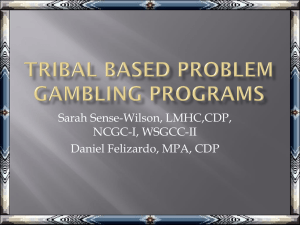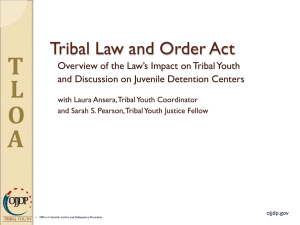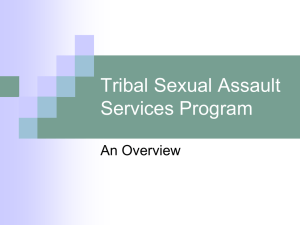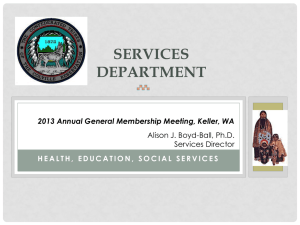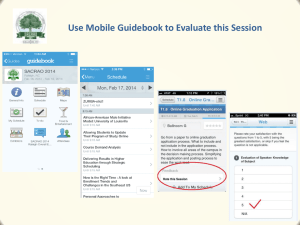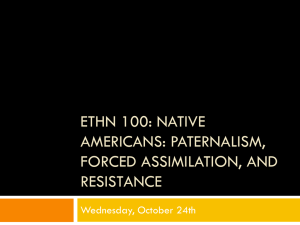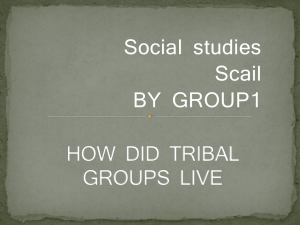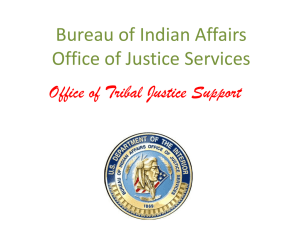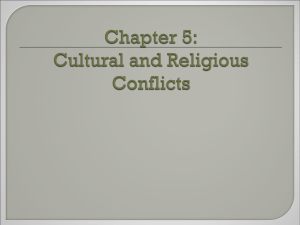Tom Geden Presentation
advertisement
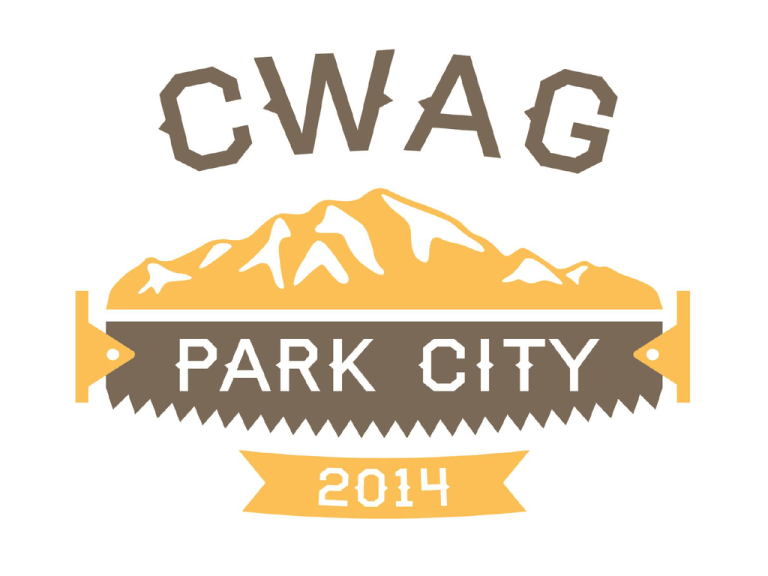
A ROADMAP FOR MAKING NATIVE AMERICA SAFER REPORT TO THE PRESIDENT AND CONGRESS OF THE UNITED STATES November 2013 Tom Gede, Member Indian Law & Order Commission tom.gede@bingham.com CWAG Annual Meeting July 2014 ABOUT THE COMMISSION • Created by Tribal Law and Order Act of 2010 (TLOA) to advise the President and Congress on Federal, State and Tribal reforms to strengthen criminal justice for the 566 Federally recognized Indian Tribes and Nations. • Extended by the Violence Against Women Act (VAWA) Reauthorization Act with sunset in January 2014. 3 • Nine volunteers appointed by the President (3) and Majority and Minority leadership of Congress (6). • Recruited three Federal experts to serve as its staff, who were “detailed.” • Planned and executed comprehensive assessment of Native American and Alaska Native public safety and criminal justice. 4 • Held field hearings, took testimony, appointed and consulted with an Tribal Advisory Board in all 12 BIA regions, and worked entirely in the field – from Alaska to the East Coast. • Unanimously prepared and approved THE ROADMAP FOR MAKING NATIVE AMERICA SAFER – a 324-page report, with 40 unanimous major recommendations. 5 • Some recommendations require: – new Federal laws – executive branch policy changes – action by the Federal judiciary – others are State-level reforms – still others are matters for Tribal citizens and their elected leaders. 6 THE COMMISSION’S GOAL • To end the public safety gap in Native American & Alaska Native communities. THE COMMISSION’S THEME • Local delivery of criminal justice works best for public safety – includes local accountability, trust and confidence 7 KEY FINDINGS AND RECOMMENDATIONS • The Federal government is largely to blame for the public safety gap in Native America. – Due to outmoded Federal command-and-control laws, policies and institutions – Indirectly through Congressionally-authorized State criminal jurisdiction over Indian people and lands through Public Law 83-280 and Congressional Settlement Act tribes. 8 • Most of United States relies primarily on locallybased criminal justice systems – local police, prosecutors, defenders, judges and juries, corrections and wrap-around services. • Federal law forces Native communities to do precisely the opposite. Tribes depend on Federal and/or State laws and agencies dispensing justice from outside their communities -- with fewer resources and less accountability to local citizens. 9 KEY RECOMMENDATIONS • Work to respect and reinforce the power of locally based Tribal criminal justice systems to protect all people and lands within Tribes’ borders • Enforce the Federal Constitutional rights of all U.S. citizens there • Achieve parity in Tribal justice funding compared with comparable parts of our country 10 JURISDICTIONAL REFORM: BRINGING CLARITY OUT OF CHAOS • Give Tribes freedom to exit the Federal criminal justice system entirely, except for laws of general application, and guarantee that same freedom to Tribes in P.L. 83-280 States. • Ensure a direct appeal from Tribal court to new U.S. Court of Indian Appeals for all criminal defendants for alleged Federal Constitution rights violations – 4th, 5th, 6th and 8th Amendments. 11 • Apply the Federal Speedy Tribal Act, 18 U.S.C. Section 3161, to all Tribal court criminal proceedings. • Amend the Indian Civil Rights Act (ICRA) to permit Tribal governments to define their own criminal laws and sentences – must be consistent with 8th Amendment. 12 MAKING ALASKA SAFER Most Alaska Native communities lack regular access to police, courts and related services. • Services are based in regional hubs that are usually remote from the communities they serve. • Village Public Safety Officers, who provide some basic services, cannot carry firearms – although most offenders do. 13 • At least 75 communities lack any law enforcement presence at all. • There is just one woman’s shelter located in Alaska’s 229 Federally recognized Native villages and no juvenile shelters at all. • Alaska Natives are 19% of the total population but 47% of reported rape victims. • Domestic violence rates for reported crimes are up to 10 times higher than the rest of the United States. 14 As one Alaska Native Tribal leader told the Commission during one of our many field visits across the state: “Every woman you’ve met today has been raped. All of us… we all know each other. Please tell Congress and President Obama before it’s too late.” 15 The Federal government and the State of Alaska should strengthen Tribal sovereignty and local selfgovernance. • Recognize some form of Indian country in Alaska to support Tribal concurrent criminal jurisdiction. • Respect Tribal court orders. • Encourage locally-based criminal justice systems. • Stop exempting Alaska Natives from Federal public safety laws. 16 STRENGTHENING TRIBAL JUSTICE • Ensure that Tribal prosecutors Federally deputized as SAUSAs – Special Assistant U.S. Attorneys – should be presumptively entitled to Federal criminal justice information, including evidence and case files, so Tribes may effectively assert concurrent jurisdiction. 17 • Enable Federal agents to serve as witnesses in Tribal court proceedings. • Monitor and improve Federal law enforcement training and performance within the Bureau of Indian Affairs – Office of Justice Services. • Develop a Federal judicial plan to enhance trials and court proceedings inside Indian county. 18 • Establish a “Special Assistant Federal Public Defender Program” to deputize Tribal defenders to receive law-enforcement sensitive Federal criminal justice information in cases involving concurrent Tribal jurisdiction. • Replace current Federal grant-funding system servicing Indian country with base-funding program for Tribes that reduces costs to U.S. taxpayers over the long run. • Reform Federal criminal justice data reporting and information systems. • Consolidate all Federal criminal justice services for Tribes in the U.S. Department of Justice to enhance performance and accountability. 20 INTERGOVERNMENTAL COOPERATION • Improve Federal law enforcement deputization programs and incentivize cross-deputation among Federal, State and Tribal agencies. • Develop model Tribal-State agreements and enhanced insurance coverage/risk management programs to enable cross-jurisdictional cooperation. • Provide Federal and State notification to Tribes at each stage of criminal justice proceedings to protect victims and enhance offender services. 21 DETENTION • Mandate notification to Tribes when offenders enter and leave the Federal Bureau of Prisons to facilitate consideration of offender placement, community supervision, and re-entry programs. • Enable Federal court sentencing to Tribal corrections and, as appropriate, alternative programs. • Streamline Federal correctional programs within one agency (U.S. Department of Justice). 22 • Codify TLOA’s BOP pilot program so Tribal courts have the permanent option of sentencing Tribal offenders to Federal detention. • Incentivize effective alternatives to detention where appropriate. 23 JUVENILE JUSTICE • The Commission’s report is one of the first comprehensive policy assessments of juvenile justice in Native America: “Indian country juvenile justice exposes the worst consequences of our broken Indian country justice system…. Federal and State juvenile justice systems take Indian children, who are the least well, and make them the most incarcerated.” 24 • Native American and Alaska Native juveniles have the highest per-capita rate of violent victimization. • Among juveniles, Native juveniles suffer PostTraumatic Stress Disorder (PTSD) at a rate of 22% – triple the general population, and exceeding or matching PTSD rates in military personnel who served in Afghanistan and Iraq. • Disproportionately high rates of Native juveniles dying from alcohol abuse, suicide, violent crime 25 REFORMING JUVENILE JUSTICE • Instead of automatically transferring Native juveniles to Federal custody in cases involving felonies, as has been mandated since 1938, • Tribes should be able to assert jurisdiction over juvenile offenders so long as Federal Constitutional rights are respected. • Should also apply to P.L. 83-280 State criminal jurisdiction - allow Tribes to develop and enforce juvenile justice laws, institutions and programs. 26 • Parole is unavailable to juveniles in Federal detention; secondary education is not provided; opportunities for incentivized rehabilitation – wellness and diversion programs, for instance – are practically non-existent. 27 RECOMMENDATIONS • The Commission recommends requiring Tribal consent to Federal prosecutions of juveniles, including whether to charge younger Native offenders as a adults. • Federal funding should follow victims and offenders, so that Tribes can more effectively address local priorities. 28 • The Federal government and States should notify Tribes at all key stages of juvenile justice proceedings involving Tribal citizens • Data/information systems should be configured accordingly. • Federal courts hearing Indian country juvenile matters ought to be required to establish pretrial diversion programs for such cases that allow sentencing in Tribal courts. 29 CONCLUSION “The Commission finds that the public safety crisis in Native America is emphatically not an intractable problem…. We see breathtaking possibilities for safer, strong Native communities achieved through homegrown, Tribally based systems that respect the civil rights of all U.S. citizens and reject outmoded Federal command-and-control policies in favor of increased local control, accountability and transparency.” 30
